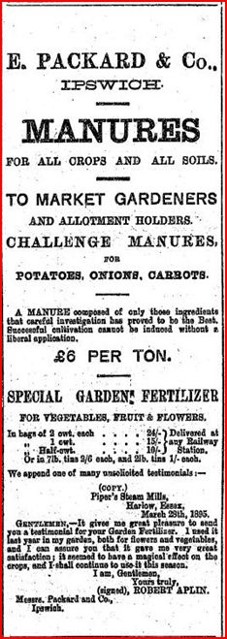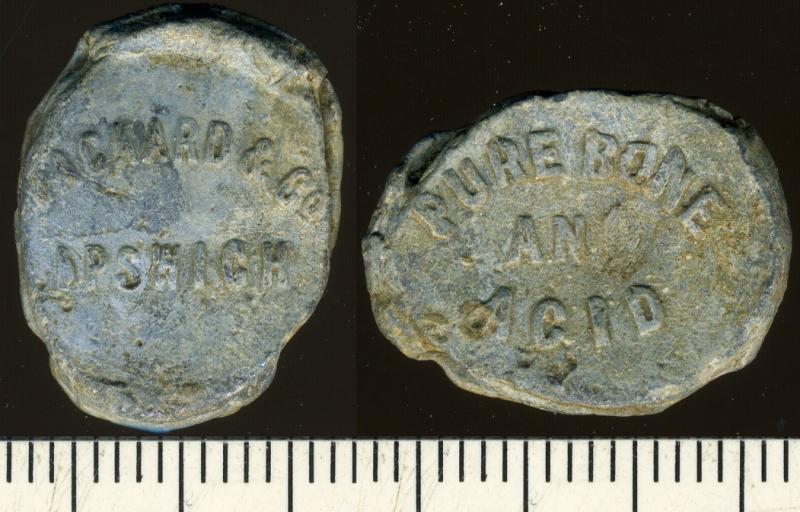What is Coprolite?
Coprolite is a phosphate-rich clay containing fossil bones and teeth of mammals and fishes. Some coprolites were fossilised excrement. The term comes from Greek Kopros for dung and Lithos for stone as coprolite was originally thought to be dinosaur poo. Whilst this is partially true it is not entirely so:
They are nodules rich in phosphate, found in the Red Crag sand (a sea bed nearly 3 million years old), particularly that underlying parishes close to the Deben estuary. … They are largely mudstone nodules, many eroded out of the underlying London Clay, becoming phosphatised and incorporated into the Red Crag. An initial thought was that they were coprolites (fossil animal droppings – possibly some are!) and thus the word coprolite became the commercial name for these phosphatic stones.
In the early 1840s a process was developed for creating superphospate fertiliser, at around the same time the coprolite phosphate nodules were found in this area. Consequently, from around 1845, this trade was shipping thousands of tons from the Deben and other locations on the Colneis Peninsula1Trade – History and Gazetter of Suffolk, William White 1855. Coprolite was extracted from pits dug in the ground: access to water transport for shipping the material to Ipswich was important so making Waldringfield, with its all-tide access, a choice location. Many pits remain in the area, they are easily identified on a LIDAR image.
GeoSuffolk Leaflets – Suffolk’s Crag Coprolites (read this if interested in Coprolite)


The coprolites were carried in carts or tumbrils in their red, wet and sandy state to near the beach for washing. Then they were tipped onto the sorting table where boys stood alongside ready to do the sorting prior to the stones being loaded onto barges. The business locally was run by Packards of Ipswich and also Fisons, the two companies merged in the 1920s. Barges collected it from Waldringfield beach: one pit was right next to the shore, and the hollow in the cliff by the steps is the result. There were other loading sites along the Deben, such as Stonnor Quay.
In 1877 10,000 tons, over a hundred barge loads, was shipped from the Deben and Orwell pits to Ipswich, so perhaps, in a year, ten or twenty barges were loaded from Waldringfield. We do not know if they brought cargo in, but it was a short voyage from Ipswich so maybe not. The material was taken to Packard’s factory in Ipswich, Coprolite Street, where it was converted into fertiliser and sold in bags. Some seals from the bags of fertiliser survive: These say Packard & Co Ipswich, Pure Bone and Acid.

Walter Tye interviewed Fred Strange of Victoria in the late 1940s and he, along with masters Drucker, Ward and Quantrill had taken loads into Ipswich. There are records in the Waller accounts of charges for Nautilus freight2Waller accounts – Suffolk Record Office Waller accounts. 1880 Nautilus Freight payment From Suffolk Record Office.. In the 1880s the Wallers had a channel dug and a wooden quay built at Stonner Point, probably for the coprolite business. Methersgate Quay could have been built by the Wallers for the same purpose3Methersgate Quay – Robert Simper in Topsail.. The trade, while it lasted, was lucrative for landowners: the Wallers, for instance, had enough surplus to build a school in the village.
The trade had a life of about half a century but died after 1897 – due to the Health and Safety legislation of the 1894 Quarries Act and the availability of cheaper sources from overseas.
Packard’s Barges
Packards used the aptly named barges Ammonite, Fossil and Nautilus as well as Dewdrop. There were also barges operated by Fisons such as Freston Tower, Haste Away and May.
Nautilus
Most is known about Nautilus, which is the only Packards barge for which we have a definite photograph.
Robert Simper relates Claude Whistock’s tale of how, when repairing Nautilus in the 1920s, after she had been impaled upon a post, gave the skipper the stump of the post and said: “You’d better keep this, it’s the soundest piece of wood in her”.
Nautilus was purchased in 1928 by Wesley Skinner of the Woodbridge barge-owning family. Details are known about her, since, in 1934, W.M.Blake spent some time recording her for Yachting Monthly. He somehow managed to draught a complete hull plan which was an impressive feat4An article in “Yachting Monthly” in 1934/5 by W.M. Blake described how she was still being used to trade on the east coast.Yachting Monthly1938 article & SSBR Compendium . According to him, she was: “As staunch and tight as the day she was launched”. It’s interesting to note that he assessed her value at £2,000 at the time: perhaps he was a better draughtsman than a surveyor? Given the enthusiasm shown by Mr Blake, maybe he converted her to a yacht5Nautilus has been built as a detailed model by Reverend William Mowll of Faversham which is also Orinoco’s home.? The article gives excellent information including that she had wheel steering: this was probably a conversion from a tiller given the date of build. Finally, in the 1950s, she was burnt at Pin Mill.


Nautilus Details
Name: Nautilus, Official No.: 95304, Owner: Wrinch, Year built: 1874, Built at: Ipswich, Built by: Curel, GRT: 45, Dimensions ft: 81.0 x 19.2 x 5.5,
Other Packards Barges
Ammonite was broken up at Pin Mill in 1933.
Name: Ammonite, Official No.: 22185, Owner: Packard, Edward, Year built: 1859, Built at: Ipswich, Built by: 0, GRT: 41, Dimensions ft: 0,
Fossil was sold to the Air Ministry in 1916 or 1920, but it is not known what became of her after that: perhaps she became a flying boat?
Name: Fossil, Official No.: 11820, Owner: Packard, Edward, Year built: 1874, Built at: Ipswich, Built by: , GRT: 37, Dimensions ft: 70.4 x 17.8 x 5.0,
Dewdrop sank in a collision with SS Dundee in the Swin on 14th January 1889, an unpleasant end in a cold sea. This was towards the end of the coprolite trade and Packards may have gone into general trading by that time since she was carrying oilcake.
Sources
The history of the Coprolite industry was covered in the River Deben Magazine in 2011.
1930s Yachting Monthly is available here.
A Contribution to the Geological History of Suffolk. Part 1 by Suffolk Naturalists’ Society – Issuu
Suffolk Crag Coprolites aw.qxp_Layout 1 (geosuffolk.co.uk)
Everton publications (bernardoconnor.org.uk)
Trimley St Martin and the Coprolite Mining Rush
GeoSuffolk Leaflets – Suffolk’s Crag Coprolites
Footnotes
- 1
- 2Waller accounts – Suffolk Record Office Waller accounts. 1880 Nautilus Freight payment From Suffolk Record Office.
- 3Methersgate Quay – Robert Simper in Topsail.
- 4An article in “Yachting Monthly” in 1934/5 by W.M. Blake described how she was still being used to trade on the east coast.Yachting Monthly1938 article & SSBR Compendium
- 5Nautilus has been built as a detailed model by Reverend William Mowll of Faversham which is also Orinoco’s home.
Image Sources and Credits
Image Credits and Sources
- AdamPackardSeal: Packard & Co Ipswich Seal from Bagseals.org
- Nautilus-from-1934-Yachting-Monthly-article-by-W.M.Blake_: 1934 Yachting Monthy article by W.M.Blake.
- 1
- 2Waller accounts – Suffolk Record Office Waller accounts. 1880 Nautilus Freight payment From Suffolk Record Office.
- 3Methersgate Quay – Robert Simper in Topsail.
- 4An article in “Yachting Monthly” in 1934/5 by W.M. Blake described how she was still being used to trade on the east coast.Yachting Monthly1938 article & SSBR Compendium
- 5Nautilus has been built as a detailed model by Reverend William Mowll of Faversham which is also Orinoco’s home.
Image Credits and Sources
- AdamPackardSeal: Packard & Co Ipswich Seal from Bagseals.org
- Nautilus-from-1934-Yachting-Monthly-article-by-W.M.Blake_: 1934 Yachting Monthy article by W.M.Blake.